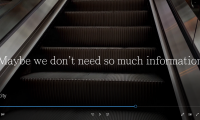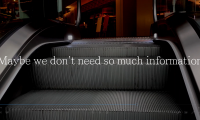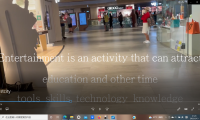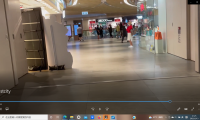Title: fast city
Director’s name: Chiu Man Yui
The theme of the video is ‘be slow in a fast city’, it reference the problem that modern people always facing: too many information.
Fast city is always related to an information city, in the video, I want to show the fast information flow, and also refer to people who are too fast.
In my opinion, people in the fast city always chasing information, and information always chasing people. Thus, I add a lot of information which are not concise because they all come from wiki ,and I cut the most important part ,and use google translate to translate it for several time to make it seems ridiculous and useless. It is a big part in my video.
I took the video use mobile phone and take some footage from city gate, which is a big shopping mall. It have all the parts that I want to show in my video. I take the footage start from escalator, because it is uniformly moving, and always can be find in a mall, thus I took many video around escalator. Besides that, to make the characteristic of a mall more easy to show, I choice the part of footage that start from an escalator, and end by an other escalator to make the whole video with same start and end.
The route from the first escalator to second escalator can find many shops and decorations which fulfil the target of ‘show it is a mall’.
There are two parts in the video.
The first part of video start by not continuous auto- reading, tells audience all parts will be auto reading.
Auto reading have a big advantage, that it do not have emotional speaking, fulfil the impression of ‘information’. To make the city looks fast, I cuts the sounds and play more than one together. And most of them are useless information. Useless information is a common problem in a fast city: everyone want to more information, and they may easily ignore the environment and people pass by.
The whole structure of the video seems very simple, as it only use one footage. As it seems just simply walking in the mall, I adjust the brightness of the video at the scene to change the mood of the start, let it do not looks so normal. The brightness always affect the mood of scene, as two picture shows below.
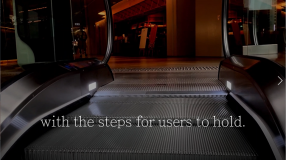

video after adjust( left) and video before adjust( right)
It may make audience felt abnormal, knows there is something wrong. I add the sound from google Translate, it increase the the feeling of ‘too many information’. Mechanical sound mixing with the background classical music, make the start more wired. The background music is emotional but the auto reading sound is unemotional, make a good contrast.
I add a lot of subtitles in the first part to make audience know what the sounds saying, because I add too many sound track and heard messy. When the subtitle added, if audience want, they can hear the word they are watching, but no others. It shows people are not good at receive too many information together.
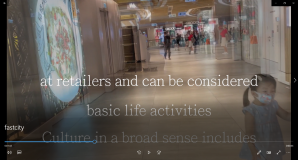
At this part, audience focus on the subtitle, and easy to ignore the environment of mall. Thus the environment appear again at second part.
Second part is started on the second escalator, then the scene connect to the first escalator.
In this part , the aim is to shows the beautiful part in the video.
At this time, the music reach the most emotional part, the final unemotional reading ended, after this part, no more sound beside the brisk background music. Audience can finally leave the information, and can see the parts that the ignore when the useless information shows. The relaxing feeling can be created by the contrast with the first time when audience follow with footage.
In the end, when the audience get close to the second escalator, the footage become darken, subtitle put the aim of the video in the video.
source:
- Abbott, C. (2016). Migratory Cities. In Imagining Urban Futures: Cities in Science Fiction and What We Might Learn From Them (pp. 72-92). Middletown, CN: Wesleyan University Press.
- Abbas, M. A. (1997). Hong Kong: Culture and the politics of disappearance (pp. 63-90). Hong Kong: Hong Kong University Press.
- Bruno, G. (2004). Architects of Time: Reel Images from Warhol to Tsai Ming Liang. Log, 2, (pp. 81- 94).
- De Certeau, M. (1984). Walking in the City. In The Practice of Everyday Life (pp. 91-110), translated by Steven Randall. Berkeley: University of California Press.
- 電扶梯 – 維基百科,自由的百科全書 (wikipedia.org)
- 資訊 – 維基百科,自由的百科全書 (wikipedia.org)
- 餘暇 – 維基百科,自由的百科全書 (wikipedia.org)
- 文化 – 維基百科,自由的百科全書 (wikipedia.org)
- 外燴 – 維基百科,自由的百科全書 (wikipedia.org)
- 娛樂 – 維基百科,自由的百科全書 (wikipedia.org)
- 餘暇 – 維基百科,自由的百科全書 (wikipedia.org)
- 休闲活动 – 维基百科,自由的百科全书 (wikipedia.org)
- 購物 – 維基百科,自由的百科全書 (wikipedia.org)
- 商場 – 維基百科,自由的百科全書 (wikipedia.org)
- Google 翻译
Chiu Man Yui 3035930448

